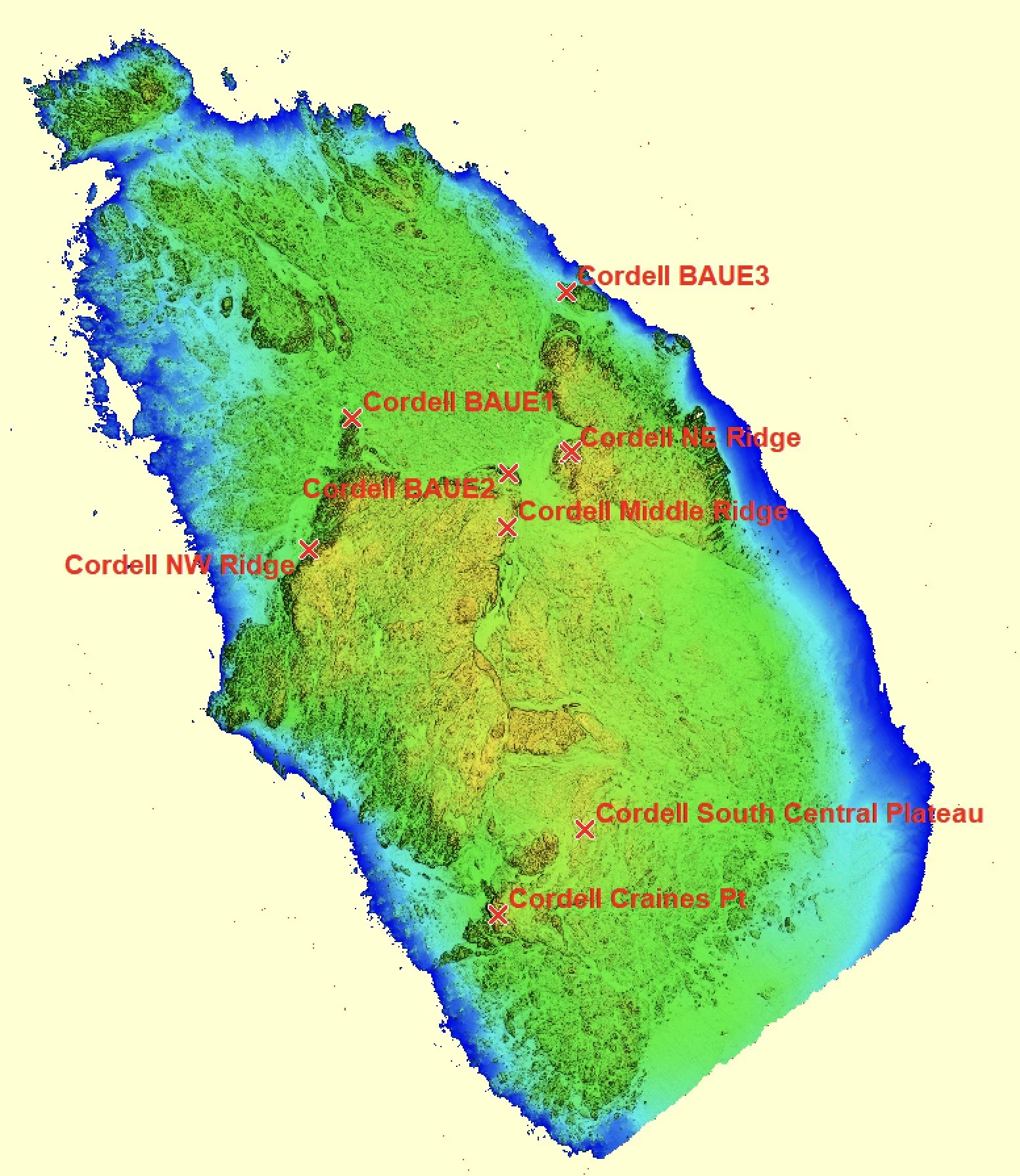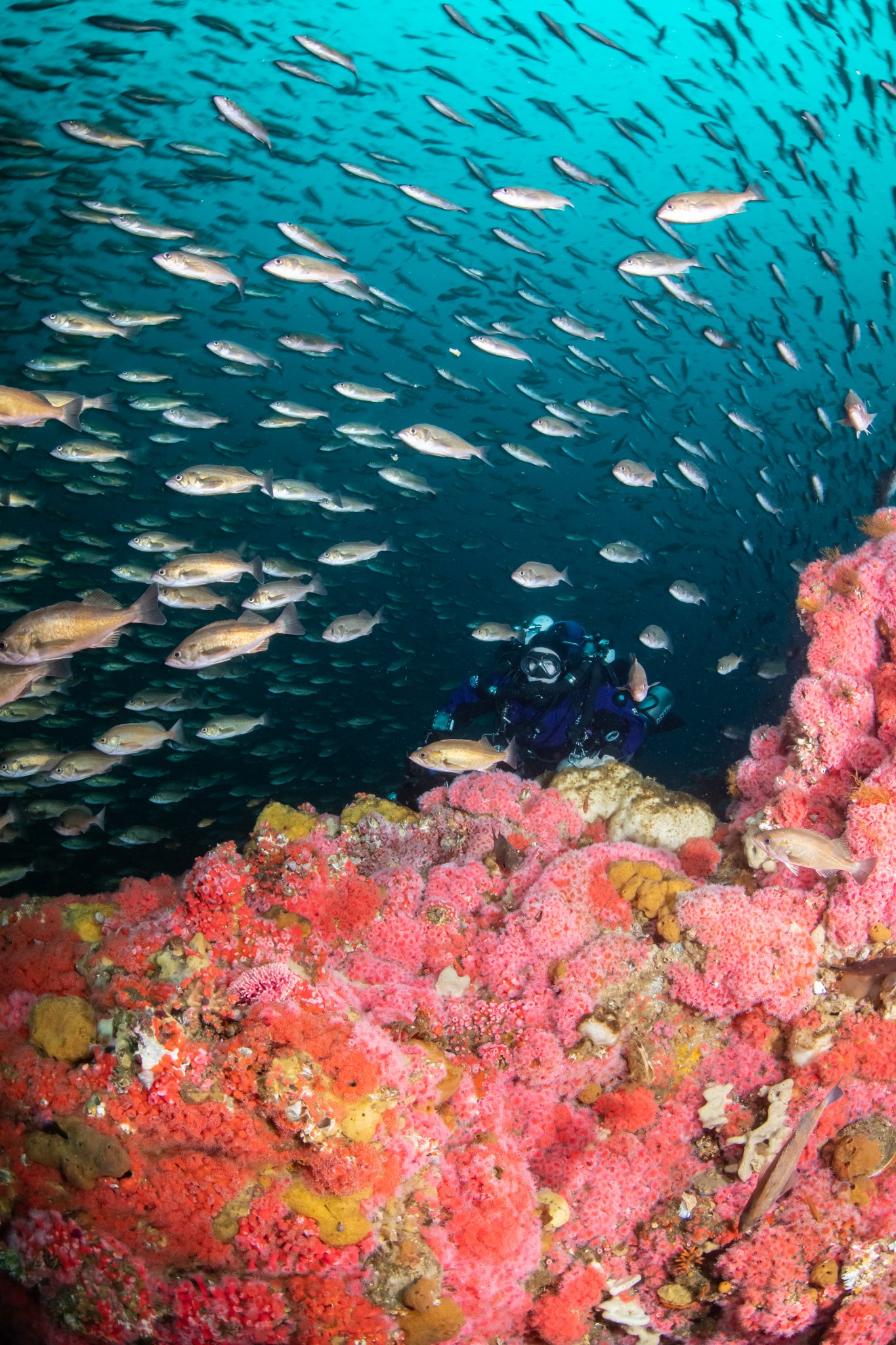Cordell Bank Exploration 2022
Widow Rockfish school over NorthWest Ridge. Photo © 2022 Robert Lee
Project Overview
Cordell Bank is a seamount located approximately 50mi northwest of San Francisco, and approximately 20mi west of Point Reyes, and lies within the Cordell Bank National Marine Sanctuary.
This ongoing project is a collaboration with Bay Area Underwater Explorers (BAUE) to explore, document, and support research and conservation efforts on Cordell Bank and within the Cordell Bank National Marine Sanctuary (CBNMS). Prior’s years work has been described on the BAUE website, and has been featured in a PBS Changing Seas documentary. This project work is conducted in consultation with and with direction from CBNMS/NOAA Sanctuaries, and is conducted under NOAA Research permit CBNMS-2021-002-A1.
The overall goals for the 2022 season were to support Cordell Bank National Marine Sanctuary (CBNMS) Education and Outreach with refreshed photo and video documentation of various sites at Cordell Bank, and to capture 360-degree video footage for use in creating a Sanctuaries 360° program on Cordell Bank. We worked closely with CBNMS as well as NOAA ONMS to accomplish this. In the end, we were able to capture 5 dives’ worth of 360° footage from 4 distinct sites, and hundreds of still photos and conventional video footage of both existing sites, as well as one site that has not previously been documented.
Bathymetric view of Cordell Bank
During the 2022 project season, Foundation divers conducted 5 days of diving operations at sites across Cordell Bank. We were also able to visit and document 2 sites that may previously not have been documented (labeled BAUE1 and BAUE2 above). We conducted the following dives (detailed reports provided in Appendix):
| Date | Site | Dive Team | Notes |
|---|---|---|---|
| 9/24/22 | NW Ridge | R.Lee, A.Lee, K. Dow | Photo, video, 360-degree |
| 9/24/22 | NW Ridge | C. Bauder, J. Heimann | Photo (Macro) |
| 9/25/22 | Cordell BAUE2 (Quillback Ridge) |
R.Lee, A.Lee, K.Dow | Photo, video, 360-degree |
| 9/25/22 | Cordell BAUE2 (Quillback Ridge) |
C. Bauder, J. Heimann | Photo |
| 9/25/22 | Cordell BAUE1 | R.Lee, K.Dow | Quick (~10min) reconnaissance & assessment of this new site. Video |
| 9/26/22 | Craine's Point | R.Lee, A.Lee | Photo, video, 360-degree |
| 10/1/22 | NW Ridge | R.Lee, A.Lee, K. Dow | Photo, video, 360-degree |
| 10/1/22 | NW Ridge | C. Bauder, J. Heimann | Photo |
| 10/2/22 | NE Ridge | R.Lee, A.Lee, K. Dow | Photo, video, 360-degree |
| 10/2/22 | NE Ridge | C. Bauder, J. Heimann | Photo |
Key Observations
Widow Rockfish on NW Ridge. Photo © 2022 Robert Lee
Fish Life
We found a wide variety of conditions when it came to the density and variety of fish life. While on some sites (e.g. NW Ridge), the schools of adult Widows and juveniles as well as YoY were quite healthy, other sites visited (e.g. the newly dubbed Quillback Ridge) were notably barren of schooling rockfish. Even within some sites (e.g. NE Ridge), schooling rockfish seemed fairly contained to specific areas - we could be on one section of reef without hardly a rockfish in sight, and move 100-200’ and be surrounded in dense schools of both adults and juveniles. In many places, it seemed as if the rockfish were spread around mid-water, and almost descended upon us from above out of nowhere once they noticed our presence. Other sites (e.g. Craine’s Point) had a decent amount of rockfish spread about, but no specific tight schools.
Collection of Rosy Rockfish at Quillback Ridge.
Photo © 2022 Clinton Bauder
Aside from schooling rockfish, we also noted several areas with abundance of non-schooling single species - most notably at “Quillback Ridge”. We found one small depression with around 10 individual Quillback Rockfish together, and another small area, with 19 small Rosy Rockfish congregating together. As usual, we also found a healthy number of mature adult long-lived species, such as Yelloweye Rockfish and Boccacio
Leucistic / aberrantly colored rockfish
Aberrantly colored Blue/Deacon Rockfish
Photo © 2022 Clinton Bauder
On multiple dives at NW Ridge, we noted several very odd colored rockfish that we had not seen before. We saw at least 3 individuals with various degrees of a distinct and high-contrast mottled black and white coloration pattern. We were able to, on our second visit to NW Ridge, capture a couple photos of this fish. Upon consulting with Milton Love (UCSB) and Tom Laidig (NOAA NMFS Research), they determined that this was most likely a small group of aberrantly colored Blue or Deacon Rockfish.
Nylon line on NW Ridge
Nylon Rope on NW Ridge. Photo © 2022 Robert Lee
We noticed a fair amount of line (at least 50’ visible, but likely with more buried in the substrate and covered with invertebrates) of nylon line, approximately ½” -1” in diameter on the reef. The line is on the top of the NW Ridge reef, and alternates between portions that are covered with invertebrate life, to areas with the bare line is visible, to areas where just the nylon core remains. Upon reviewing photos from our 2016 expedition, we found at least one photo from the same site showing the line as well, so it has been there at least since 2016, and likely longer than that. The line looks consistent with nylon or polypropelene line that one might find on crab pots or used with commercial fishing gear (vs. dockline or other rigging lines).
More “holes” in Reef
The team found additional circular vertical “holes” in the reef, consistent with what we had seen in prior year’s expeditions which were also consistent with what the Schmeider expedition teams had found. We found the holes that we had seen before at NE Ridge, as well as 2 new holes at the new site dubbed Quillback ridge. While one hole was appeared almost perfectly circular (and was around 6’ in diameter), the other hole was much larger (approx 15-20’ in diameter) and had a somewhat irregular shape to it’s perimeter.
Hole in the Reef. Photo © 2022 Robert Lee
Hole in the Reef. Photo © 2022 Robert Lee
Surface Observations
During our diving days travelling to and from Bodega Bay, we encountered a variety of marine life. Surface conditions were generally calm with winds 10kts or less. We encountered fewer seabirds than we had in the past (a few albatross, shearwater and murres). For marine mammals, we saw fur seals, Dall’s porpoises, and humpback whales. Notably, while we saw one or two humpbacks at Cordell Bank itself (and on several dives could hear whalesong underwater), we encountered the majority of the whales about halfway between Bodega Bay and Cordell Bank. We were showing what looked like significant masses of baitfish on our depth-sounder, and the whales were congregating and moving consistent with feeding.
Data and Documentation
We collected 5 dives’ worth of 360-degree Boxfish video footage, several hundred still photos (both macro as well as wide-angle), as well as several dives’ worth of conventional video footage. The collected media will be provided to CBNMS staff electronically, and made available for public-use.
Additionally, the team participated in several interviews and surface filming for a NOAA Stories from the Blue program, and will be working with the NOAA ONMS video team on post-production work.
Project Team
For the 2022 season, we relocated our dive-vessel (Escapade) from Monterey to Bodega Bay for the season. We used a rotating crew and set of captains (all of which were experienced and knowledgeable in our dive operations and procedures) based on the weather dates that were most suitable for diving.
| Team Member | Role |
|---|---|
| Clinton Bauder | Diver, Photo |
| Jared Berg | Boat Captain |
| Jim Capwell | Boat Captain |
| Gavin Chilcott | Crew |
| Kevin Dow | Diver |
| Paul Festa | Crew |
| Keith Flood | Crew |
| John Heimann | Diver |
| Allison Lee | Diver, Video |
| Rob Lee | Diver, Photo, 360-Video |
| Mike Minard | Boat Captain |
| Billy Palmer | Crew |
| Jenny Stock | NOAA CBNMS Outreach |
| Nick Zachar | NOAA Videographer |
Project Team. Photo © 2022 Nick Zachar





















